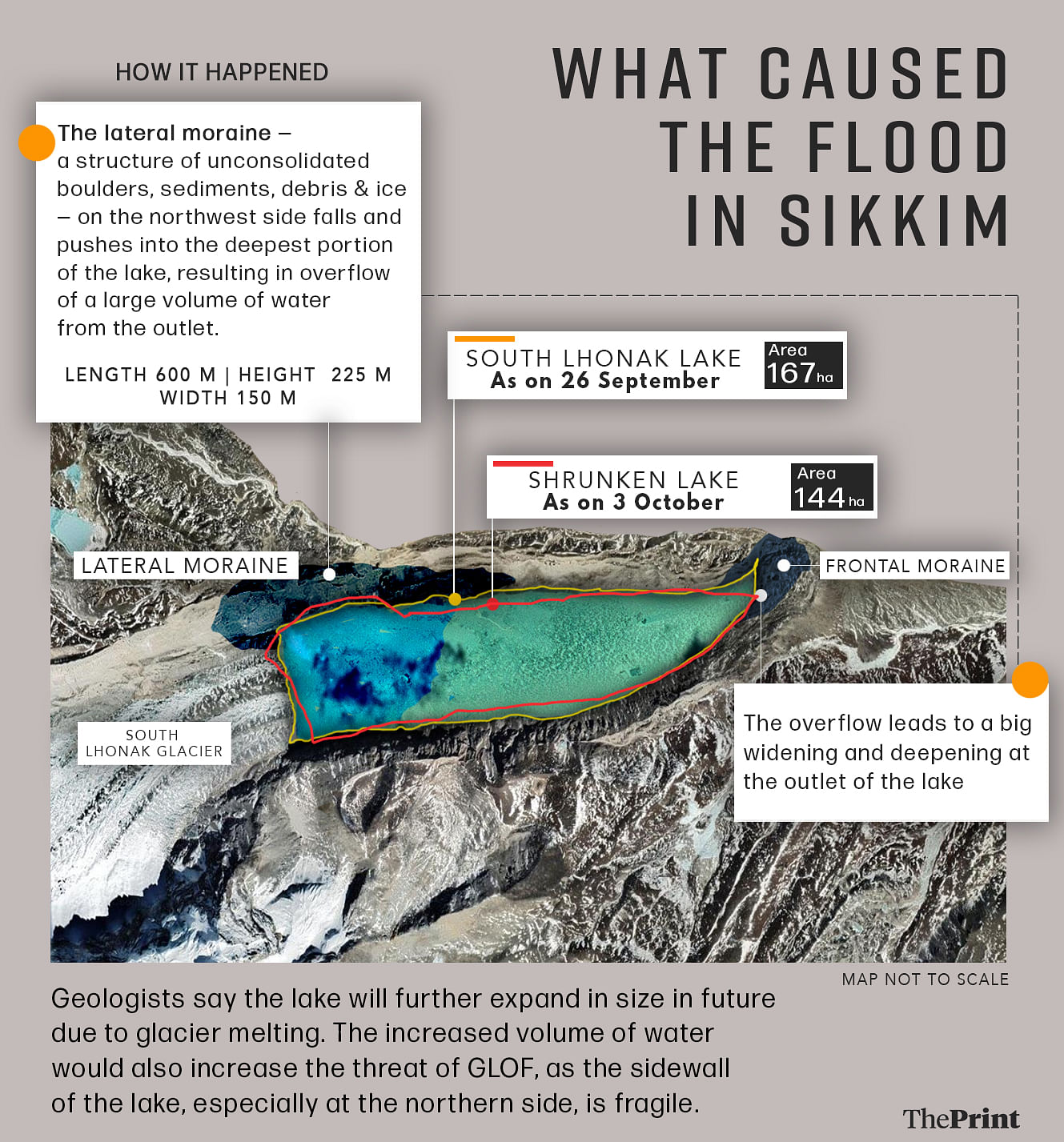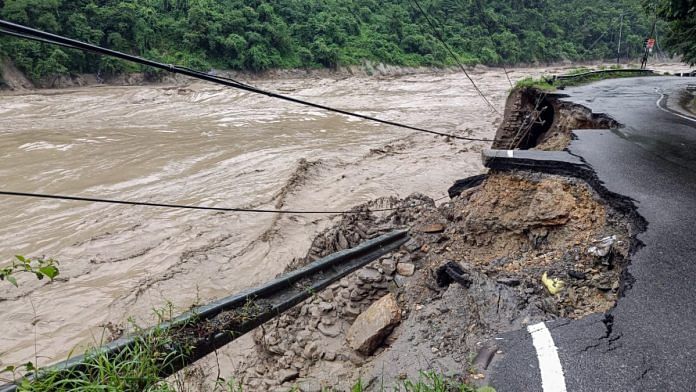Gangtok: A deadly flood hit Sikkim on 3 October when the South Lhonak glacial lake burst its banks, but the danger isn’t over yet. Experts and Sikkim government officials told ThePrint that the lake still poses a threat.
So far, 89 lives have been lost and 100 people are missing. Though no formal assessment has been done, state government officials said that physical infrastructure worth several thousand crores was damaged.
The devastating incident has been described as a glacial lake outburst flood (GLOF), which occurs when lakes formed by melting glaciers suddenly breach.
But despite the overflow of water, satellite images show that the South Lhonak lake has only marginally reduced in area since the flood. This suggests that a GLOF cannot be ruled out.
Scientists from the Sikkim government’s Science & Technology Department, who assessed satellite images from Sentinel-2, a European high-resolution imaging mission, said that the lake’s area dropped only slightly from 167 hectares on September 26 to 144 hectares on October 6.
Dhiren G. Shrestha, principal director in the Science & Technology Department, added that a moraine — a structure of unconsolidated boulders, sediments, debris, and ice — is still holding the water in the lake. “The lake is largely intact though the area has reduced,” he said.

According to him, while it appears that the immediate danger has lessened because a significant amount of water has overflowed, causing the lake level to drop, the threat of a GLOF persists.
“The lake will further increase in its size due to glacier melting and inflow from the North Lhonak glacier,” Shrestha explained.
Ashim Sattar, a scientist at the Indian Institute of Science who had assessed the hazard potential of the South Lhonak lake back in 2019, concurred. He told ThePrint that though the 3 October outburst has reduced the water in the lake, primarily fed by the South Lhonak glacier, there is potential that the lake could grow in the future.
Notably, in a 2021 paper published in the peer-reviewed journal Geomorphology, Sattar and seven other co-authors detailed the future GLOF hazard of South Lhonak lake.
They noted that the “enormous volume of water in a highly dynamic high-mountain environment makes this lake a priority for GLOF risk management”. They also found that “GLOF susceptibility will increase due to the expansion of the lake towards steep slopes, which are considered potential starting zones of avalanches”.
The paper further warned that many settlements along the valley, including the largest town Chungthang, “are at high risk”.
Also Read: How an alert ITBP jawan on duty 8 km away from South Lhonak lake raised 1st flood alarm in Sikkim
What exactly happened on 3 October?
What occurred on 3 October is still under investigation and the Sikkim government is wary of calling it a GLOF event yet, but satellite images provide some insight.
V.P. Pathak, Sikkim chief secretary, told ThePrint that the available India Meteorological Department (IMD) data does not support a cloudburst as the probable cause. For a cloudburst to happen, there has to be very high rainfall in a short time.
“Though we need to study further to find out what was the trigger, our scientists after going through the Sentinel-2 satellite images say that there has been a detachment of the lateral moraine on the northwest side of the South Lhonak lake,” Pathak told ThePrint.
The lateral moraine measured approximately 600 metres in length, 225 metres in height, and 150 metres in width.
“What we know from the satellite images is that the moraine fell into and pushed into the deepest portion of the lake resulting in overflow of a large volume of water from the outlet,” Shreshtha explained.
“The overflow led to a big widening and deepening at the outlet of the lake, but we have to ascertain the depth and volume of the lake. The increased volume of water would also increase the threat of GLOF or a similar situation, as the sidewall of the lake, especially at the northern side, is fragile,” he added.
Sattar, too, confirmed that the 3 October glacial lake outburst originated in the lateral moraine.
“It impacted the lake in the deeper part, thereby creating impulse waves eventually leading to a widening of the lake outflow channel,” he said.
Geologists now stress the importance of assessing the lake’s volume, moraine stability, and potential displacements in other parts of it.
Dr Rakesh Kumar Ranjan, head of the department of Geology at Sikkim University, told ThePrint that satellite images from 6 October show the outlet of the South Lhonak lake has deepened and widened as compared to what it was before October 3.
“Water is going out of the outlet but at the same time there is an accumulation of water also. The satellite images show water from another lake in front of the Northern Lhonak lake is also getting added to the South Lhonak lake,” he said.
Ranjan said that is why it is important to conduct a comprehensive assessment of the lake’s depth. The geologist also pointed out that at the same time the government needs to take note of other potentially hazardous glacial lake formations in the area.
“Our department under DST’s Centre for Excellence is currently working on glacier research in Sikkim Himalaya, which shows that there are many other glacial lakes prone to GLOF in the region. The government needs to assess and take measures like siphoning off the water,” he said.
He added that the state government should also address the rampant encroachment on riverbeds to minimise loss of lives.
Work was on to install early warning system
Shrestha said that a team of scientists from the state government’s Science & Technology Department had gone on an expedition to South Lhonak lake on 13-14 September to measure the volume of the water.
The team sent a remote-controlled boat to do a bathymetry survey — conducted to measure depth and map underwater features — and found that the water near the snout (mouth of the glacier) of South Lhonak lake was approximately 120 metres deep.
“The study is being done to prepare for installing an early warning system,” Shrestha said.
Scientists have pointed out the need to install an early warning system on the South Lhonak lake for a long time.
In a report tabled in March this year, the parliamentary standing committee on water resources pushed for an early warning mechanism to monitor GLOF hazards.
It also stressed the need for a multi-hazard alert and warning system for the Indian Himalayan region, noting that most such existing systems only deal with individual disasters.
For example, the India Meteorological Department has a system for issuing alerts and warnings for heavy rainfall and cloudbursts, but it does not have any warning systems for other disasters such as GLOFs, avalanches, or landslides.
“These disasters are either dealt with by other agencies or there exist no warning systems for them. To deal with these disasters in an integrated manner, a Multi-Hazard Warning System may be put in place through a real-time coordinated mechanism wherein one agency may be entrusted with the responsibility of continuously monitoring and issuing warnings and alerts to authorities, stakeholders and public,” the report said.
(Edited by Asavari Singh)
Also Read: What turned Teesta into a killer? Here’s proof Sikkim flash floods are a man-made disaster



